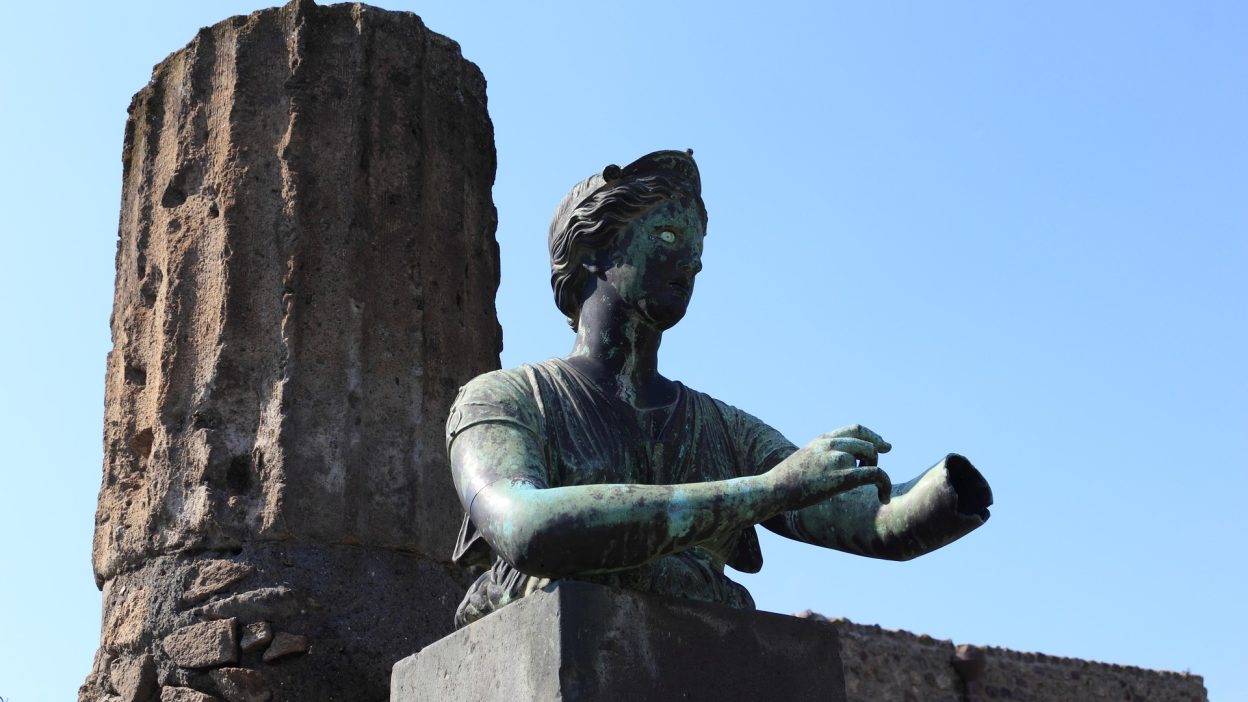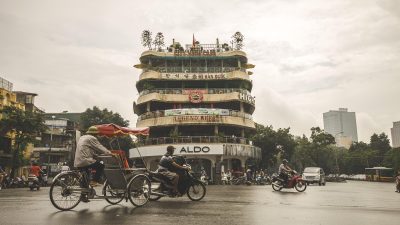The Cataclysmic Eruption That Wiped Pompeii Off The Map
1. Pompeii’s Golden Age: A City Unaware of Its Looming Doom
In 79 AD, Pompeii was a thriving Roman settlement, bustling with trade, culture, and luxury. Positioned near the Bay of Naples, it was a hub of activity, with grand villas, intricate mosaics, and streets lined with taverns and markets. The city was a testament to the success of the Roman Empire—one that no one believed could be erased overnight.
However, beneath the vibrant city lay a hidden monster—Mount Vesuvius, a sleeping volcano that had been inactive for centuries. While minor earthquakes were common in the region, they were dismissed as routine geological activity. Even a major earthquake in 62 AD, which caused significant destruction, was seen as an unfortunate but fixable event. Instead of fearing their mountainous neighbour, Pompeii’s people rebuilt their homes and continued living their lives, unaware that the tremors were actually warnings of an impending catastrophe.
The residents of Pompeii lived in the shadow of destruction, blind to the reality that their paradise was about to become a city frozen in time under a tomb of volcanic ash.
2. A Sky Turned to Fire: The Eruption That Obliterated Pompeii & Herculaneum
On the fateful morning of 24 August 79 AD, Mount Vesuvius erupted with unimaginable force, sending a column of ash, pumice, and superheated gases high into the sky. Witnesses, including the Roman historian Pliny the Younger, described the explosion as resembling a “pine tree, with smoke billowing into the sky before collapsing under its own weight.”
The eruption unfolded in two deadly phases. The first phase saw volcanic debris raining down, covering Pompeii and Herculaneum in a thick layer of pumice and ash. This alone made movement difficult, as streets became impassable, and roofs caved in under the weight.
As night fell, the second and deadliest phase began. A series of pyroclastic surges—clouds of searing gas, rock, and ash moving faster than 100 km/h—rushed down the slopes of Vesuvius. Anyone caught in its path was incinerated instantly. Pompeii was buried under six metres of volcanic debris, while Herculaneum was engulfed in volcanic mud so thick that parts of it remained hidden until modern excavations.
By the next morning, the once-thriving cities had ceased to exist. What remained was a landscape of death, eerily silent beneath the layers of destruction.
3. Death in the Ashes: The Horrifying Toll of Vesuvius’ Wrath
The human cost of Vesuvius’ eruption was staggering, with thousands perishing in mere hours. Here’s a breakdown of the devastation:
- Estimated Death Toll
While exact figures remain unknown, historians believe that between 16,000 and 20,000 people lost their lives. Some died from suffocation as volcanic ash clogged their lungs, while others were caught in collapsing buildings. - Pompeii’s Frozen Victims
Excavations revealed haunting plaster casts of people preserved in their final moments—bodies curled up in agony, hands shielding faces, lovers embracing as they met their fate. The victims’ agony was etched into the hardened volcanic ash, turning them into eerie statues of death. - The Tragedy of Herculaneum
Unlike Pompeii, where many suffocated slowly, Herculaneum’s residents were killed instantly. The heat exceeded 500°C, boiling bodies and causing skulls to explode from the pressure. Archaeologists found skeletons of entire families who had tried to flee, only to be swallowed by the firestorm.
The sheer scale of death left behind a ghostly scene—one where time had stopped at the moment disaster struck.
4. Could Pompeii’s People Have Escaped? A Disaster of Hesitation and Misunderstanding
Historians argue that many of Pompeii’s residents could have survived had they evacuated earlier. But why did so many remain behind despite the warning signs?
The primary reason was a lack of understanding. Volcanic eruptions were not well documented in the ancient world, and many residents did not realise the danger until it was too late. Even when tremors grew stronger, they were viewed as ordinary earthquakes, not signals of impending doom.
When the volcano finally erupted, some people tried to escape, while others hesitated, unsure whether it was safer to stay indoors or flee. The streets became chaotic, filled with people running, buildings collapsing, and ash falling like rain. Those who took refuge inside suffocated as toxic gases filled the air, while those who fled too late were overcome by pyroclastic flows, which incinerated everything in their path within seconds.
Survival was possible—but for many, hesitation proved fatal.
5. The Science of Doom: How Pyroclastic Flows Wiped Out Pompeii
Mount Vesuvius’ most terrifying weapon was its pyroclastic flows—avalanches of superheated gas, ash, and rock that travelled faster than a race car and reached temperatures hot enough to melt metal.
When the pyroclastic surges swept through Pompeii, they:
- Burned people alive within seconds, leaving behind nothing but bones.
- Collapsed buildings, burying thousands under the weight of volcanic debris.
- Vaporised everything in their path, turning the vibrant city into a lifeless wasteland.
Scientists believe the heat was so intense that it caused people’s blood to boil and their skulls to explode from pressure. Even today, pyroclastic flows remain among the deadliest volcanic hazards, capable of wiping out entire communities within minutes.
6. Was It Divine Punishment? How Romans Interpreted the Disaster
To the Romans, the eruption of Vesuvius was not just a natural catastrophe—it was a punishment from the gods.
Many believed that Pompeii had become a city of sin and excess, and the gods had unleashed their wrath upon it. Some historians argue that the destruction of Pompeii was seen as a moral lesson, a warning against indulgence and corruption.
Even today, some people suggest that Pompeii’s fate was “deserved”, echoing ancient beliefs that natural disasters are punishments for human transgressions.
7. Rediscovering Pompeii: A City Lost for 1,500 Years
- Buried and Forgotten
After the eruption, Pompeii and Herculaneum were abandoned. Over centuries, the cities became legends, their exact locations lost. - Accidental Rediscovery
In 1599, workers digging a water channel stumbled upon ancient frescoes. However, the true excavation didn’t begin until the 18th century, unearthing streets, villas, and even graffiti that had remained untouched for nearly two millennia. - A Glimpse into the Past
Pompeii’s ruins offer an unparalleled window into ancient Roman life, preserving artefacts, artwork, and daily routines in astonishing detail.
8. Could Mount Vesuvius Erupt Again? The Unsettling Truth
Mount Vesuvius is not a dormant volcano—it is still very much active, and scientists warn that it could erupt again at any time. The last major eruption occurred in 1944, but geologists believe that the volcano is overdue for another large-scale event.
What makes Vesuvius especially dangerous is the millions of people living in its shadow today. Unlike in 79 AD, where Pompeii and Herculaneum had a combined population of around 20,000 people, modern-day Naples and its surrounding areas are home to over 3 million residents. If another massive eruption were to occur, it could lead to one of the worst natural disasters in modern history.
Scientists constantly monitor Vesuvius for signs of activity, but even with modern technology, predicting the exact timing of an eruption remains extremely difficult. While evacuation plans exist, history has shown that people often hesitate to leave their homes, just as Pompeii’s residents did nearly 2,000 years ago.
If Mount Vesuvius erupts again with the force it did in 79 AD, the devastation could be unimaginable. The question remains: Are we truly prepared, or will history repeat itself?
9. Lessons from Pompeii: A Warning for the Modern World
The tragedy of Pompeii is not just a story of the past—it is a cautionary tale for the future. It reminds us that nature is unpredictable, and disasters can strike at any moment.
Despite all our advancements in science and technology, human behaviour remains the same. Just like the people of Pompeii ignored the warning signs, many today live near active disaster zones, believing that catastrophe won’t happen in their lifetime. Earthquakes, tsunamis, hurricanes, and volcanic eruptions continue to claim thousands of lives because of human complacency.
Governments and scientists work tirelessly to improve early warning systems, but these systems are useless if people fail to take action when danger approaches. The story of Pompeii teaches us that disasters don’t wait for us to be ready—either we prepare, or we suffer the consequences.
Will we learn from history, or will we become the next Pompeii?
10. Pompeii’s Eternal Legacy: A City Preserved in Tragedy
Today, Pompeii stands as a chilling reminder of the power of nature. Unlike other ancient cities that disappeared over time, Pompeii’s destruction ironically led to its preservation. The volcanic ash that buried it also protected its ruins, giving modern archaeologists an almost perfectly preserved snapshot of Roman life.
The city has become one of the world’s most famous archaeological sites, attracting millions of visitors each year. Tourists walk through its well-preserved streets, visit homes with stunning frescoes, and stand before the plaster casts of its victims, frozen in time.
But beyond being a historical wonder, Pompeii is a warning. It teaches us that even the greatest civilisations can be destroyed in an instant, and that ignoring nature’s warnings can be fatal. The echoes of Pompeii’s past still whisper a message to the modern world:
“Disaster does not wait. Neither should we.”
FAQs
1. How many people died in the eruption of Mount Vesuvius in 79 AD?
It is estimated that between 16,000 and 20,000 people died, mostly from suffocation, heat exposure, or building collapses. Many were trapped in their homes, while others perished trying to flee.
2. How long did the eruption of Mount Vesuvius last?
The eruption lasted for over 24 hours, beginning on 24 August 79 AD and continuing into the next day. It had two phases: an initial ashfall followed by deadly pyroclastic surges that wiped out Pompeii and Herculaneum.
3. Why were the people of Pompeii unable to escape?
Most residents did not realise the danger in time. Many ignored the warning tremors, thinking they were just earthquakes. When the eruption began, ashfall made it difficult to see and move, and later, pyroclastic flows incinerated everything instantly.
4. Can Mount Vesuvius erupt again?
Yes, Mount Vesuvius is still active, and scientists believe it could erupt at any time. The last eruption occurred in 1944, and Naples, home to over 3 million people, is now at high risk if another major eruption occurs.
5. What makes Pompeii’s discovery so important? Pompeii’s ruins offer an unparalleled look into ancient Roman life. Because the city was buried so quickly, its streets, homes, and even the bodies of its people were perfectly preserved, giving us insights into a lost world frozen in time.




